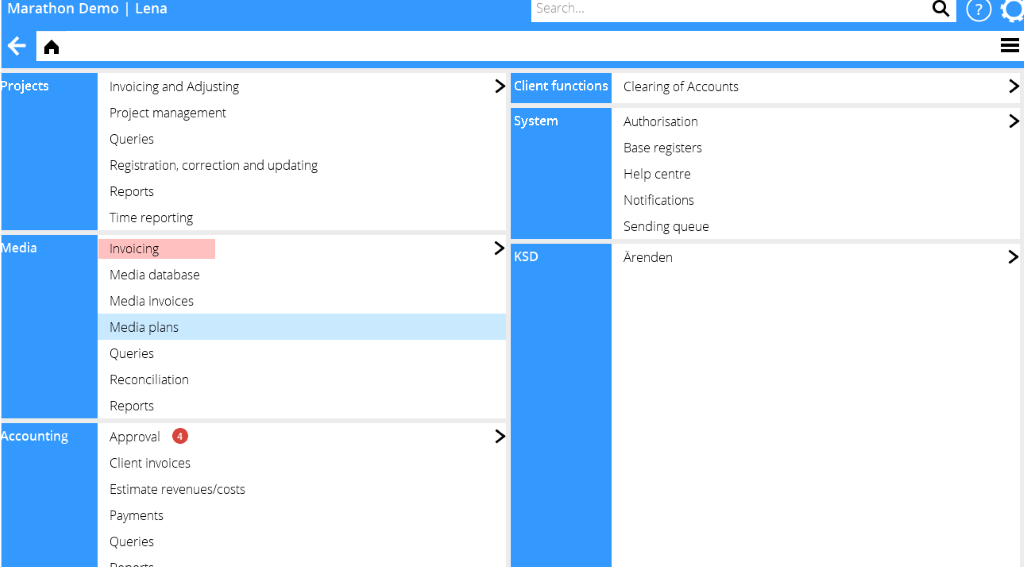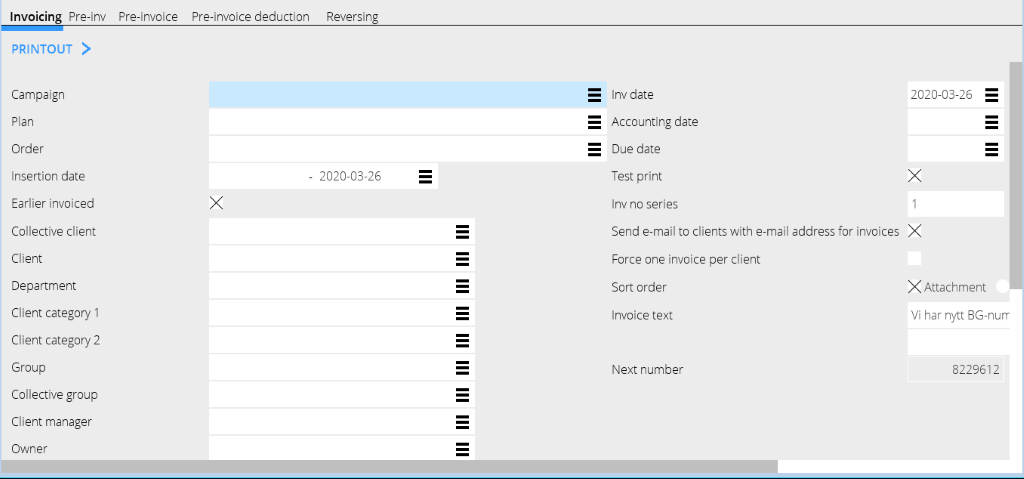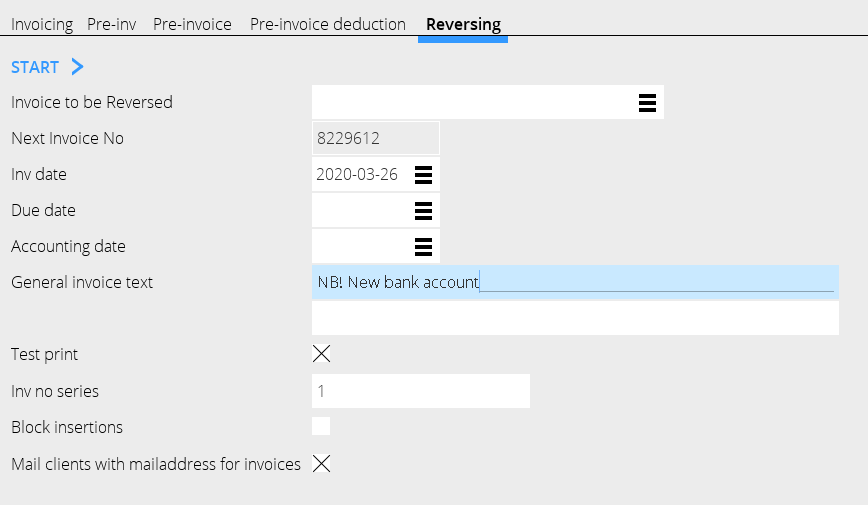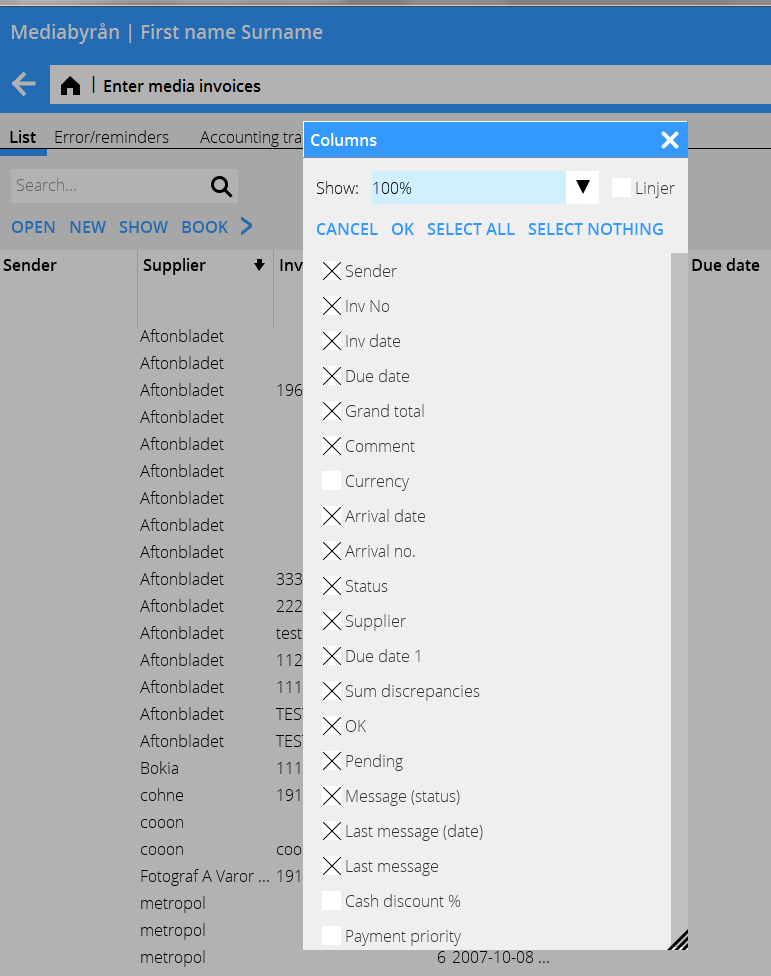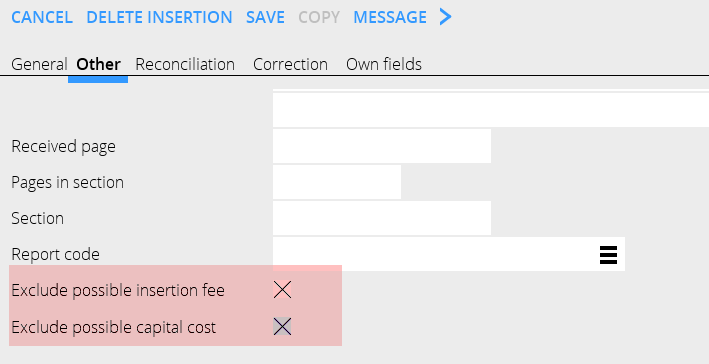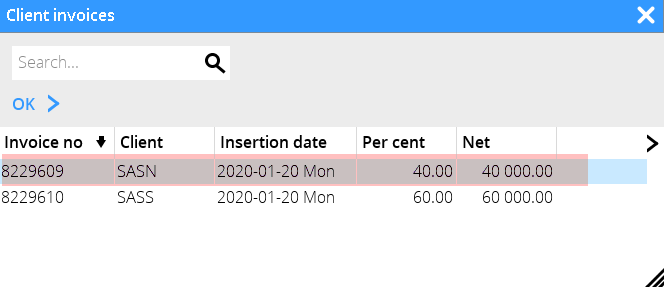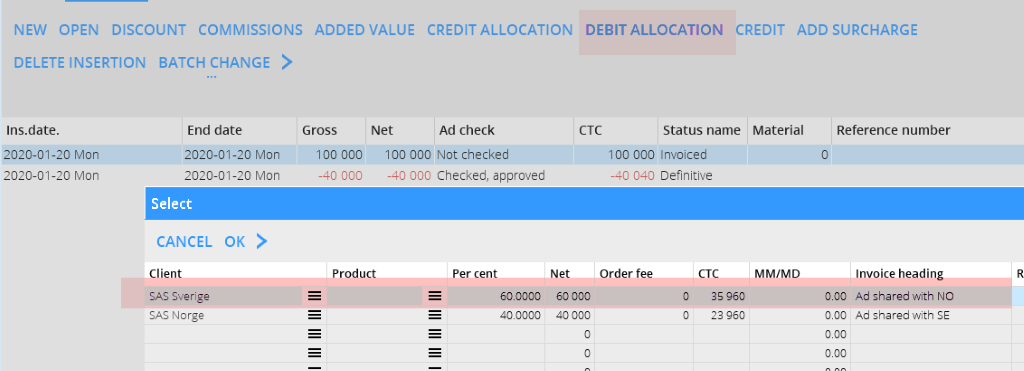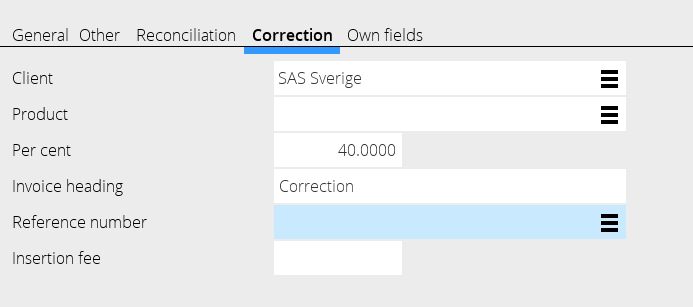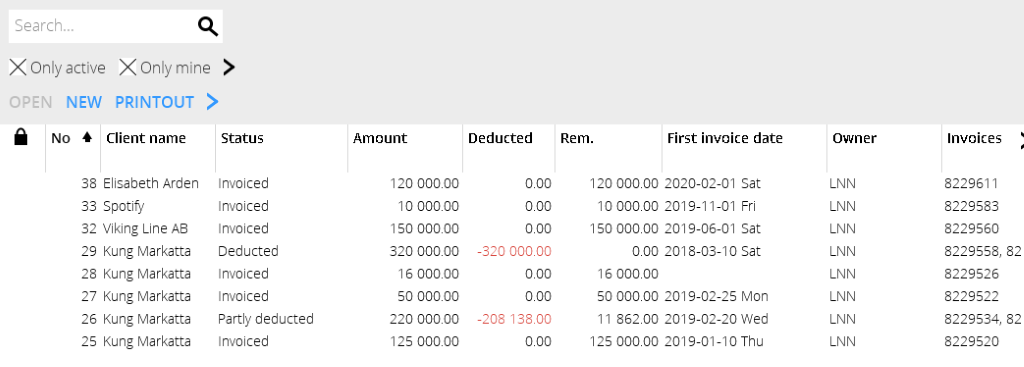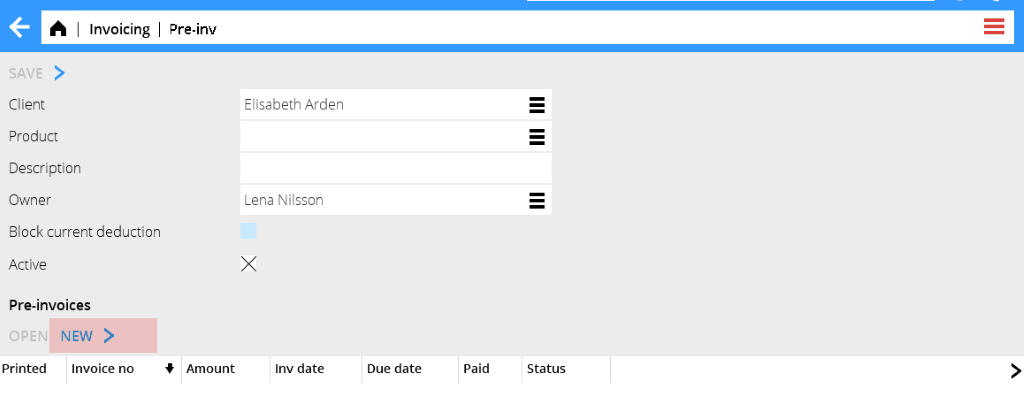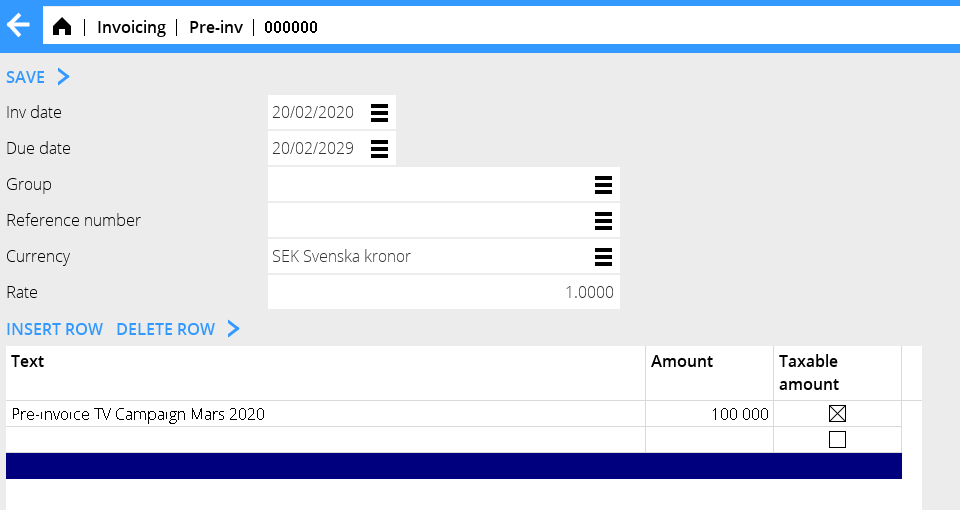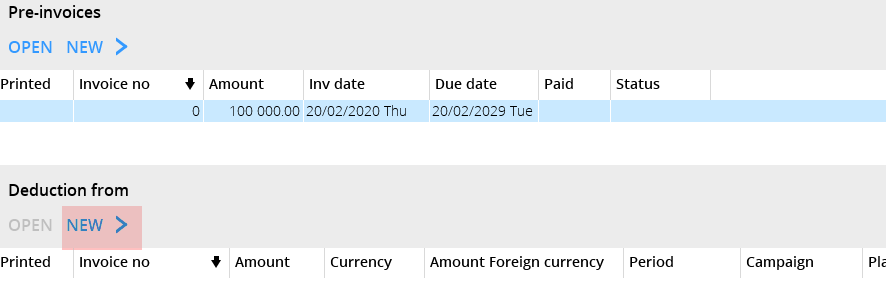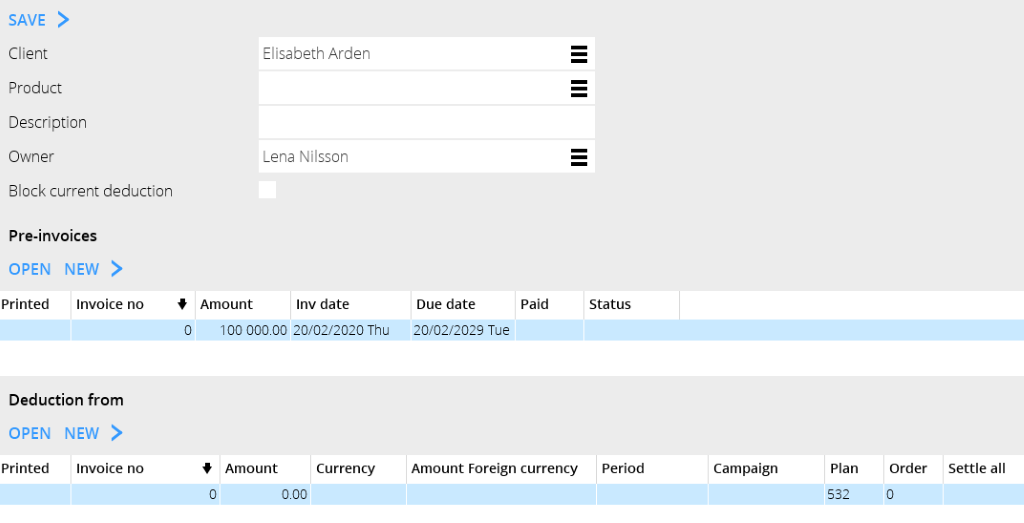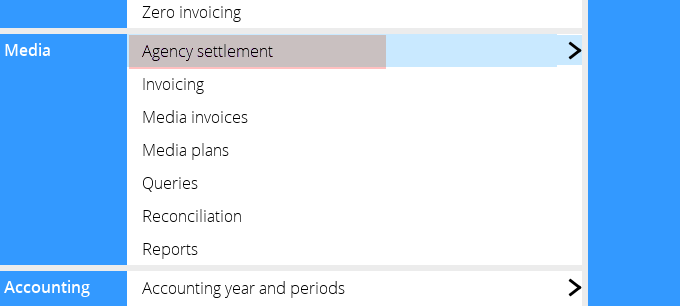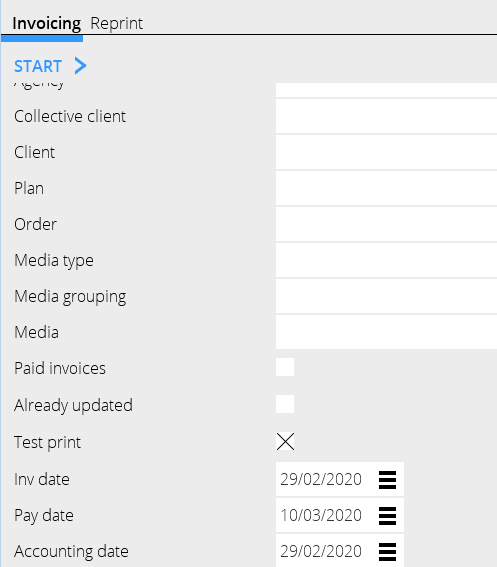Media Økonomi
Contents
Fakturering
All fakturering gøres i MEDIA/FAKTURERING, ogsp acontofakturering og afregninger.
Du kan selektere på indrykningsdato, budgetnummer, kunde, kundekategori, etc. Dersom I fakturerer pr. kampagne, kan det også vælges.
Hvis du fakturerer en særskilt mediegruppe eller kunde kontinuerlig, kan gu gemme selekteringen til neste gang. Klik på en blåe pil for mer oplysninger.
| Løbende fakturering | Hvis dette felt er blankt, skrives alt ud, uanset "Løbende faktureing" på aftalen eller ikke. Hvis du bare ønsker at fakturere budgetter/ordrer med "løbende fakturering", væjg JA. |
|---|---|
| Også ikke kontrollerede | Ved JA skrives indrykningene ud selv om de ikke er blevet annoncekontrollerede, forudsat at budget-/ordrenumemr er angivet. |
| Referencenummer mangler | Hvis NEJ her, bliver alle ordrer med referencenummer fakturerede, forudsat at kunden har " Fakturér kun ordrer med referencenummer" aktiveret. |
Hvis JA, vil alle budgetter/ordrer uden referencenummer blive fakturerede forudsat at kunden angivit det som obligatorisk
Hvis Blank, skrives alt ut, men kun i testudskrift.
I basisregistrens kunderegister findes en parameter" Fakturér kun ordrer med referencenummer". Hvornår den vælges må parametern være på JA. Hvis du vælger en forkert kombination, får du en feilmeddelelse og kan ikke fortsette faktureingen
| Debit/kredit | Blank = alt faktureres.
Debit = Kun debitfakturaer udskrives. Kredit = Kun kreditnotaer udskrives. Separate = debit- og kreditfakturaer faktureres separat. |
|---|---|
| Korrektioner | Indrykninger markeet med korrektion (x) kan faktureres separat.
Ja = inkludér korrigeringer No = inkludér ikke korrigeringer Separate = ifakturér genereller fakturaer og korrigeringer på separate fakturaer Int = kun interne korrigeringer |
| Fremtving én faktura pr. kunde | Hvis afkrydset overstyres kundens minimumbeløb. |
Generel fakturatekst kan skrives for hver faktureing.
Kreditér/vend faktura
Dersom hele fakturaen er fejl kan du kreditereden i fanebladet Kreditering.
| Spær indrykninger | Betyder at hvornår en faktura krediteres, bliver alle indrykninger spærrede så, at de ikke kan blive fakturerede. Hvis feltet ikke er afkrydset bliver indrykningene bookede og kan senere genfaktureres. |
|---|---|
| Send e-mail … | Ikke lægrere i brug. Brug fakturadistribution i Økonomi: Fakturadistribution. |
Kreditér/Vend indrykninger
Åbn ordren og indrykningen. Vælg indrykning og tryk på KREDITER
Indrykningen bliver kreditetet, dvs den bliver en kreditindrykning og mærkes med en korrektion. Det indebærer at du kan vælge at fakturere kreditten separat i den løbende fakturering. Vælg hvis du vil at den tidligere fakturanummer bliver lagt til som kommentar.
Hvis du vil kreditere en indrykning uden at inkludere indrykningsgebyr eller fee, kan du eksludere dem.
Det gøres i fanebladet Øvrigt inde i indrykningen.
Krediter dele af fordeling
If you have an allocation and you only wish to credit one of the clients, you are practically “moving” the cost to another client.
| Example: |
|---|
The client SAS Norge shall be credited, and the client SAS Sverige shall be debited instead, meaning the latter shall pay the whole amount.
Proceed like this: 1. Open the order and select the insertion that shall be corrected. Use CREDIT ALLOCATION.
2. Select the invoice to be credited, press OK.
3. Select the insertion to be debited (the original insertion, not the credit).
4. Use DEBIT ALLOCATION.
5. Select the post that shall be debited again /SAS Sverige) and press OK.
6. Select the new debit insertion and open it. Under the tab Correction, change the client to SAS Sweden and write a possible invoice comment.
7. Save. Two new invoices will be printed out at next invoicing. One credit invoice to SAS Norway and a new debit invoice to SAS Sweden.
Pre-invoicing
The list in the Pre-invoice tab shows the status of the pre-invoices; the invoice amount, deduction amount and deducted invoices, and remining amount. Deduction from shows definitive orders that are available for deduction
There are two ways to pre-invoice based on the client agreement:
• The client is pre-invoiced and a controlled deduction is made. Not current pre-invoicing.
The client is pre-invoiced, and all definitive insertions are deducted currently. Current pre-invoice deduction.
New pre-invoice:
Make a new pre-invoice in the tab Pre-invoice Note, that it is not possible to deduct pre-invoiced from another client.
Enter client and possible owner (if you want to sort and search within your own in the list)
Block current deduction = the pre-invoiced is not deducted at the current pre-invoice deduction.
3. Enter invoice date, due date and text with amounts. Choose if the pre-invoice is taxable or not. Save and printout in the tab Pre-invoice. If you already know what plan/order the pre-invoice shall be deducted from, you can fill in that before printing out the invoice.
Enter plan, order or campaign. If you select “Deduct all”, you cannot enter anything in the fields, these are default settings.

The description field can be very useful.
When the time for deduction comes, it is done either in Invoicing (if current deduction) or in the tab Pre-invoice deduction (if controlled deduction). Enter here the pre-invoice number that shall be deducted. Possible surpluses/deficits are invoiced as debit- or credit invoices and the pre-invoice is settled.
| To keep in mind: |
|---|
When invoicing clients with agreements based on Current pre-invoice deduction, the system starts with the oldest pre-invoice. If there is nothing that matches the conditions for the pre-invoice, it goes to the next one.
Reconciliation of media discrepancies/ Discrepancy handling
Book away discrepancies in Media: Reconciliation.
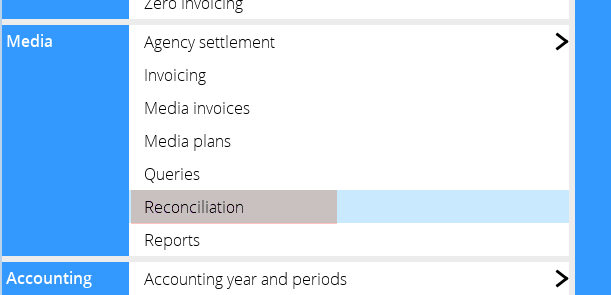
You can make a selection based on reconciliation codes, owner, client, date and many other fields. You can save your selection if you use it often.

| Discr Net /Discr Net-net | Describes how big discrepancies that shall be shown in the list.If you don’t want to see all the insertions, write 1-999 999 999 in Discr. Net-net. The setting to see booked away discrepancies is 0-999 999 999 in both fields. |
|---|
The amount in the list showing Discr Net-net is reconciled with the media deduction account.
Select only “to accounting date” if you want to reconcile with the deduction account, nothing else.


Order the column so that you can see all relevant information. Use the arrow on the right in heading row to see all column options.
| Open | Open the order to deepen into it |
|---|---|
| Create corrections | Creates a new insertion of the selected insertion's net-net discrepancy, depending on the discrepancy either a negative or a positive one. The new insertion can later be invoiced to client. |
| Book away | See below. |
| Reconciling code | Changeable. |
| Reconciling comment | Possibility to add or edit comments. |
| Change order number/ins. date | Here you can move the media invoice of the insertion to another insertion. See further description below. |
| Change owner/client | Change owner or client. This requires a parameter setting that allows change. |
| Show invoice | Shows an invoice copy in PDF format, if the invoice has been scanned. |
| Printout | Prints the reconciling list. Requires a special print template from Kalin Setterberg. |
Book away discrepancies
Select one or several rows and click on BOOK AWAY.
Enter accounting date. You can also book away only a part of the amount by changing the amount, as well as the account.
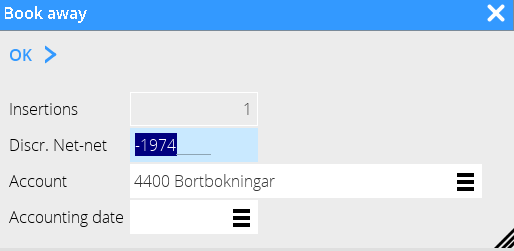
Move media invoice to another order or insertion date.
The function Change order number/insertion date is used for moving an invoice that has been erroneously registered. Select the order and click on the function. Enter the media invoice (searchable in the list) and the order number and insertion date, where the invoice shall be moved. It is only possible to move to an existing order and insertion date. If only a part of the invoice shall be moved, enter amount.

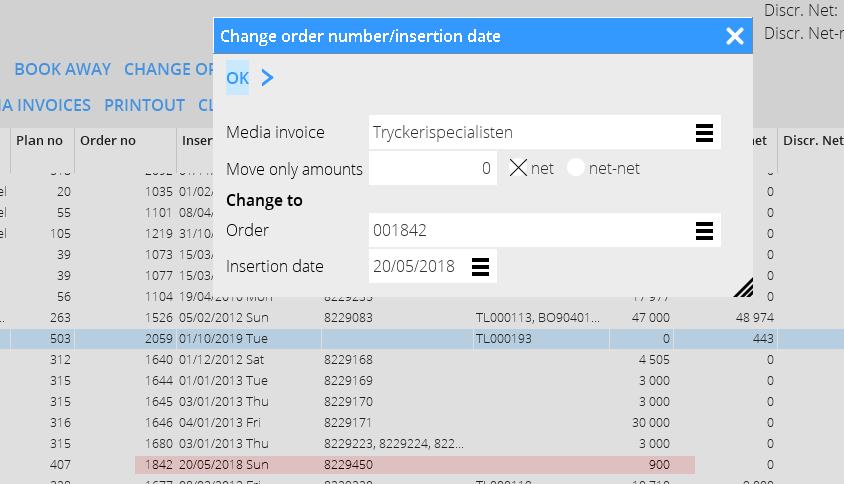
Agency settlement
For clients, whose agreements allow a part of the commission, working fee and other fees to the advertising agency, the agency on the client is used for an agency settlement. When printing the settlement, a supplier invoice is created on the corresponding supplier in the purchase ledger. It will later be paid as a normal supplier’s invoice.
Create agency in Base registers/MED/Agencies.
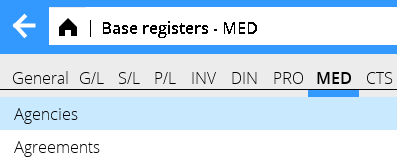
In the client record in Base registers/MED/Clients, enter the agency in the tab Parameters 1.
On the client agreement in Base registers/MED/Agreements, state how big part/how many percent units of insertion fee, agency commission and capital cost you want to pass on to the advertising agency. The invoice and the agency settlement document are printed out under Agency settlement
Select agency and accounting date or other selection. You can make different selections if for example a certain media only shall be settled against a certain plan.
| Paid invoices | If selected, only paid client invoices are taken into the settlement |
|---|---|
| Already updated | If selected, it is possible to reprint the specification |
| Reprint | All agency settlements can be reprinted. |
Invoice projects together with the media invoice
If you want to invoice project invoices together with media invoices, you have to activate a parameter in Media/Parameters/invoicing. The invoicing is made in the media invoicing part and in the project invoicing part you state on the invoice, which plan the invoice concerns. Create an invoice as normally in Adjusting/Invoicing and connect it to a plan in the tab Parameters.
The media invoice template must be updated such that it fetches information from the Project accounting.
